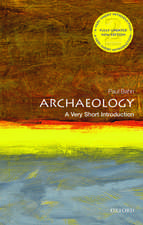The Traffic Systems of Pompeii
Autor Eric E. Poehleren Limba Engleză Paperback – 22 oct 2020
| Toate formatele și edițiile | Preț | Express |
|---|---|---|
| Paperback (1) | 225.97 lei 31-37 zile | |
| Oxford University Press – 22 oct 2020 | 225.97 lei 31-37 zile | |
| Hardback (1) | 614.27 lei 10-16 zile | |
| Oxford University Press – 2 noi 2017 | 614.27 lei 10-16 zile |
Preț: 225.97 lei
Preț vechi: 240.43 lei
-6% Nou
Puncte Express: 339
Preț estimativ în valută:
43.24€ • 44.68$ • 35.97£
43.24€ • 44.68$ • 35.97£
Carte tipărită la comandă
Livrare economică 08-14 martie
Preluare comenzi: 021 569.72.76
Specificații
ISBN-13: 9780197541395
ISBN-10: 0197541399
Pagini: 296
Ilustrații: 62 illustrations
Dimensiuni: 234 x 155 x 18 mm
Greutate: 0.41 kg
Editura: Oxford University Press
Colecția OUP USA
Locul publicării:New York, United States
ISBN-10: 0197541399
Pagini: 296
Ilustrații: 62 illustrations
Dimensiuni: 234 x 155 x 18 mm
Greutate: 0.41 kg
Editura: Oxford University Press
Colecția OUP USA
Locul publicării:New York, United States
Recenzii
This is a thorough, and very well documented book about a topic that has been waiting for a systematic treatment for decades.... The main line of argument always remains clear, and is where necessary clearly illustrated with high-quality maps, and pictures. This, in other words, is a book that will last. It has a clear relevance now, and will still have its relevance in twenty, thirty years' time.
The book is a major contribution to the study of infrastructure, traffic, urban streets and networks, and municipal management. It is remarkable for the completeness and authoritativeness with which it treats the topic of vehicular traffic throughout the empire, and the depth and degree of detail it provides about its primary case-study.
The Traffic Systems of Pompeii is an exemplary product of Poehler's long-term engagement with the archaeology of urban spaces ... this volume should be mandatory reading for every student of the ancient world who despairs at the apparent insolubility of historical questions, who argues against the subordinate position of archaeology in discussions of human activity, and who seeks a theoretical and methodological guide to best practice in making sense of the past.
In this book, longtime Pompeii insider Eric Poehler blends (1) a bench scientist's gift for critical analysis, (2) an apparently-encyclopedic knowledge of the city's streets and archival material, and (3) his own pioneering method for detecting and scrutinizing patterns of the wheeled traffic that scarred, scraped, and rubbed against Pompeii's stones. The result is the most extensive, systematic, technical, and archaeologically rich contribution to the study of Pompeian traffic to date. All interested in this city, and even Roman urbanism more generally, will want The Traffic Systems of Pompeii on their shelf and in their bibliography.
Based on brilliant archaeological detective work this book is destined to become a Pompeian classic. Poehler makes the technical details of the city's infrastructure come alive every bit as much as does the tour de force view of the traffic system through the eyes of Sabinus the Muleteer in chapter 7. The importance of this study for our understanding of Roman urbanism is difficult to overstate.
This is the strangest and most delightful history of the city of Pompeii that you'll ever read.
The book is a major contribution to the study of infrastructure, traffic, urban streets and networks, and municipal management. It is remarkable for the completeness and authoritativeness with which it treats the topic of vehicular traffic throughout the empire, and the depth and degree of detail it provides about its primary case-study.
The Traffic Systems of Pompeii is an exemplary product of Poehler's long-term engagement with the archaeology of urban spaces ... this volume should be mandatory reading for every student of the ancient world who despairs at the apparent insolubility of historical questions, who argues against the subordinate position of archaeology in discussions of human activity, and who seeks a theoretical and methodological guide to best practice in making sense of the past.
In this book, longtime Pompeii insider Eric Poehler blends (1) a bench scientist's gift for critical analysis, (2) an apparently-encyclopedic knowledge of the city's streets and archival material, and (3) his own pioneering method for detecting and scrutinizing patterns of the wheeled traffic that scarred, scraped, and rubbed against Pompeii's stones. The result is the most extensive, systematic, technical, and archaeologically rich contribution to the study of Pompeian traffic to date. All interested in this city, and even Roman urbanism more generally, will want The Traffic Systems of Pompeii on their shelf and in their bibliography.
Based on brilliant archaeological detective work this book is destined to become a Pompeian classic. Poehler makes the technical details of the city's infrastructure come alive every bit as much as does the tour de force view of the traffic system through the eyes of Sabinus the Muleteer in chapter 7. The importance of this study for our understanding of Roman urbanism is difficult to overstate.
This is the strangest and most delightful history of the city of Pompeii that you'll ever read.
Notă biografică
Eric E. Poehler is Associate Professor of Classics, Director of the Five Colleges Blended Learning and Digital Humanities programs, and Co-Director of the Pompeii Quadriporticus Project at the University of Massachusetts Amherst. He has published widely on Roman urbanism, infrastructure, and architectural history.














